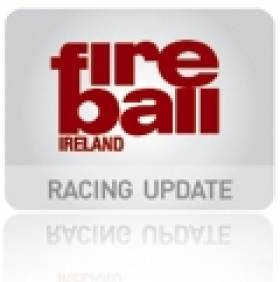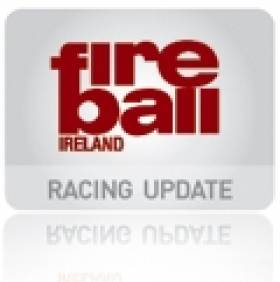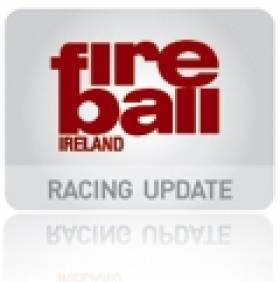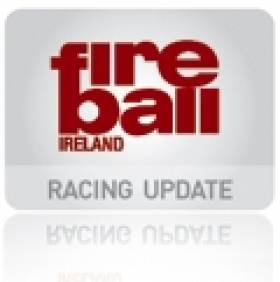Displaying items by tag: Shetland
#fireball – Tom Gillard & Richard Anderton (GBR 15081) are the new Fireball European Champions. In today's final day of racing they won two of the three races to win the regatta, after discard, by a 6pt margin writes Cormac Bradley.
In 2nd place overall are Matt Burge & Richard Wagstaff (GBR 15093), followed by David Wade & Tim Hartley (GBR 15113) with these two being separated by 3pts.
The young Irish combination, Barry McCartin & Conor Kinsella (IRL 15114) finished fourth overall, losing out to Wade by a solitary point. However, they will be buoyed by the fact that they took the last race of the regatta to break the stranglehold that the British boats had on racer wins.
In 5th place overall are the Czech combination Jaroslav Verner and Jakub Napravnik (CZE 15110).
Principle Race Officer, Bruce Leask and his team, produced a hat-trick of three-race days to give the fleet a second discard, to the relief of some. Wind today was out of the east and started a bit light but grew stronger as the day wore on, so much so that the "pumping flag" was broken out for the last race.
Burge and Wagstaff's day came unstuck with some wayward results but in truth two race wins today for Gillard & Anderton is where the damage was done to the former's campaign. Wade and Hartley too had a good day with a 2, 3, 3, suite of results.
Among the ladies, Louise McKenna & Hermine O'Keeffe (IRL 14691) in 17th were first with Maja Suter & Thomas Boehm (SUI 14921) 5pts adrift of the Irish combination.
In home fleet terms, Will'm Mouatt and Neil Fraser (SHE 14402) take the honours, their regatta highlight being a 4th place finish in Race 8.
Homecoming Scotland 2014 Fireball European Championships
Lerwick, Shetland. Sail No. R1 R2 R3 R4 R5 R6 R7 R8 R9 Nett
1 Tom Gillard & Richard Anderton GBR 15081 4 2 2 1 3 1 1 1 2 10
2 Matt Burge & Richard Wagstaff GBR 15093 5 1 1 2 1 2 7 5 4 16
3 David Wade & Tim Hartley GBR 15113 2 4 4 4 2 3 2 3 3 19
4 Barry McCartin & Conor Kinsella IRL 15114 1 6 6 3 4 5 4 2 1 20
5 Jaroslav Verner & Jakub Napravnik CZE 15110 3 3 3 5 6 6 8 6 5 31
6 Jiri Paruzek & Jakub Kosvica CZE 14551 8 7 5 6 5 14 3 27 6 40
7 Alex Taylor & Geoff Edwards GBR 15046 6 5 7 7 27 4 5 27 7 41
8 Will'm Mouatt & Neil Fraser SHE 14402 27 11 8 9 9 16 6 4 9 56
9 Scott Nicolson & Roger Goudie SHE 14513 15 8 10 8 7 8 10 9 11 60
10 Frank Miller & Ismail Inan IRL 14713 13 10 11 12 10 9 12 15 12 76
Fireball Euro Racing Scrubbed in the Shetlands
#fireball – Thursday's racing at the Homecoming Scotland 2014 Fireball European Championships didn't happen as Bruce Leask, Principle Race officer was beaten by the elements and was thus unable to get a race in writes Cormac Bradley. The fleet set out for the race course shortly after 12 noon for a scheduled 13:00 start, to the backdrop of a third cruise liner in Lerwick Harbour in as many days. With a forecast of dropping wind strength as the day wore on, the omens were not good. The presence of the second largest floating crane in the world would have influenced where the race course could be set but initially this enormous piece of engineering excellence didn't influence where we might be sailing.
However, the wind refused to co-operate and despite the persistent attention of the Race Team, they flew racing's equivalent of the white flag, "N over A" shortly after 15:00. A long sail home was shortened by the mark boats offering multiple tows to the competitors.
Tonight we have the UK Fireball Association "setting out their stall" for the 2015 Worlds in Pwllheli, Wales.
Tomorrow, Friday, is the last day of the regatta and there must be the prospect of an earlier start to the day to try and recover at least one of today's lost races.
For the present though, the scoreboard stays the same, which means that Matt Burge and Richard Wagstaff (GBR 15093) lead by two points from Tom Gillard and Richard Anderton (GBR 15081).
Attachments: pdf of results after Day 2 and six races.
Britian Lead, Ireland Fifth at Shetland Fireball Europeans
#fireball – Although the seascape at 07:30 this morning suggested otherwise for the Fireball Europeans, Principle Race Officer Bruce Leask was able to get the three races he had programmed for the day completed here in Lerwick, thus allowing the regatta to get started writes Cormac Bradley. The day had started off with a postponement of one hour but shortly after 12 noon that came down and the fleet was advised to set out for the race area.
At midnight last night (Sunday), XCWeather was predicting that the wind would be WNW and very light initially but building during the day without getting into double figures. On the race course the wind direction was fluctuating around 260˚ but not be severe amounts on the start line. Three races were sailed in moderate trapezing conditions – not too severe – with the conventional Olympic course used in all three races. The first race was shortened after the downwind sausage leg but the other two, on a smaller physical course, ran their full length.
Race 1 honours went to the young Irish combination Barry McCartin and Conor Kinsella (IRL 15114) who initially were behind Dave Wade and Tim Hartley (GBR 15113), but pulled ahead on the second beat to lead and win by a comfortable margin. The podium had a three nation flavour with Wade and Hartley in 2nd and Jaroslav Werner and Jakub Napravnik (CZE 15110) in 3rd. Also included in the lead bunch that set the pace for everyone else were Tom Gillard and Richard Anderton (GBR 15081) with Matt Burge and Richard Wagstaff (GBR 15093) closing out the top five. The balance of the top ten were Alex Taylor & Geoff Edwards (GBR 15046), Maja Suter & Thomas Boehm (SUI 14921), Jiri Paruzek & Jakub Kosvica (CZE 14551), Ondrej Labuda & Karel Otto (CZE 14262) and Darren & Craig Forrest (SHE 14395). The racing was tight and there were skirmishes going on around the course but nothing excessive!
The PRO and his team had already modified the position of the weather mark in Race 1, but while we were sailing the sausage leg of that race, he also modified the position of the gybe mark, making the course smaller.
The "usual suspects" were at the front of the second race with an almost reversed order of finishing (relative to the first race). Going right seemed to pay most dividends, certainly from this correspondent's perspective. This time is was Matt Burge & Richard Wagstaff who came from behind to take the lead to win comfortably at the finish. Indeed the front five or six got away from the body of the fleet but none of them were able to close the gap on the boat in front of them. The sausage downwind produced a variety of approaches with some sailing round the mark and going right for a short distance before coming back left. Others gybed immediately. The breeze was a bit stronger but not by much. The two reaches of the triangle were challenging but the second one was by far the tighter.
After a race that lasted just less than an hour (or thereabouts) the finishing order was Burge/Wagstaff, Gillard/Anderton, Verner/Napravnik. Wade & Hartley and Taylor & Edwards were both scored 4th which must be a first! McCartin & Kinsella were 6th, Paruzek & Kosvica 7th, Scott Nicolson & Roger Goudie (SHE 14513) 8th, Louise McKenna and Hermine O'Keeffe (IRL 14691) 9th, and Frank Miller & Ismail Inan (IRL 14713) 10th.
Another quick turnaround by PRO Bruce Leask saw the third race started and delayed by the first General Recall of the day. Needless to say it was quickly followed by the first black flag start of the day though this stricter starting regime of starting claimed no miscreants! Again, going right was favoured by the "hot-shots" and this time my recall is that Tom Gillard & Richard Anderton set the pace before, yet again, Burge & Wagstaff took up the pace-setting duties. Also prominent at the head of the fleet were Alex Taylor & Geoff Edwards. This time, this correspondent was closer to the action to watch five boats fight each other for the lesser places. The downwind leg of the sausage was very competitive as boats went one way and then another is an attempt to gain an advantage. However, nobody could dislodge Burge & Wagstaff who sailed home to a second win and top spot after Day 1.
Behind them the order was Gillard, Verner, Wade, Paruzek and McCartin.
Bruce Leask and his team are to be commended for getting three races in, particularly when we only went afloat after 12 noon. Proceedings were finished around 17:30 and the completion of three races means that we are only one race behind schedule. Sunday's XCWeather prediction was for more wind on Tuesday which means there is a real chance that we could be back on programme this time tomorrow.
Homecoming Scotland 2014 Fireball European Championships Sail No. R1 R2 R3 Tot. Nett
1 Matt Burge & Richard Wagstaff GBR 15093 5 1 1 7.0 7.0
2 Tom Gillard & Richard Anderton GBR 15081 4 2 2 8.0 8.0
3 Jaroslav Verner & Jakub Napravnik CZE 15110 3 3 3 9.0 9.0
4 David Wade & Tim Hartley GBR 15113 2 4 4 10.0 10.0
5 Barry McCartin & Conor Kinsella IRL 15114 1 6 6 13.0 13.0
6 Alex Taylor & Geoff Edwards GBR 15046 6 4 7 17.0 17.0
7 Jiri Paruzek & Jakub Kosvica CZE 14551 8 7 5 20.0 20.0
8 William Mouatt & Neil Fraser SHE 14402 DNF 11 8 31.0 31.0
9 Scott Nicolson & Roger Goudie SHE 14513 16 8 10 34.0 34.0
10 Frank Miller & Ismail Inan IRL 14713 14 10 11 35.0 35.0
The fleet have gone clay pigeon shooting this evening. Some may have on the water frustrations to work out at that session. Tomorrow's plan is for another three races.
#fireball – The first day of the Fireball Europeans, sponsored by Homecoming Scotland 2014 and being hosted by Lerwick Boating Club in Shetland was lost to a combination of mist and very light wind. Principle Race Officer Bruce Leask has originally signalled a 1-hr postponement after the skipper's briefing but that became an indeterminate postponement.
An excellent fish lunch was then served at the host club before racing for the day was abandoned shortly after 15:00.
The fleet has now dispersed but many will reconvene later at the Club to make their way to a curry buffet at a local restaurant in Lerwick, the regatta's culinary choice for this evening.
Cormac.
#fireball – One of Ireland's Fireball top medal hopes, Barry McCartin and Conor Kinsella, have this week had the chance to tune their new boat even further while winning the Shetland Nationals event, a warm-up for the Europeans in which all visiting sailors who were there for the Europeans were invited to participate.
The guys are fresh from winning the Irish Fireball Munsters at Wexford Harbour Boat and Tennis Club last weekend, which gave them a clean sweep of the three Fireball major events to have taken place so far this season, the Ulsters and the Open Championship having gone their way as well.
With no racing on Thursday due to fog, Friday was the only race day available, Saturday being measurement day for the big one, so only four races were able to be sailed in total. McCartin and Kinsella dominated the fleet, posting results of 2,1,1,1 to take the title in style – and win a beautiful trophy as shown in the pic above!
As for the Europeans, the first race was due on Sunday, though again there were wind problems, but they're hoping for better conditions tue-fri this coming week. Here's hoping all the Irish crews who have travelled all that distance contribute to a great Irish result overall!
Uk Coastguard Announces Public Meeetings to Discuss Modernising Service
The purpose of the meeting is to provide an opportunity for the local communities around the existing Maritime Rescue Coordination Centres (MRCCs) to hear more about the proposals, ask questions of MCA representatives and have the opportunity to express their views.
Each meeting will be independently chaired and will begin at 7:30pm, expecting to draw to a close by 9pm.
Humber - Monday, 21 February 2011, The Spa, South Marine Drive, Bridlington, East Yorkshire. YO15 3JH
Thames - Tuesday 22 February 2011, Columbine Centre, Princes Esplanade, Walton on the Naze, Essex. CO148PZ
Yarmouth - Wednesday 23 February 2011, Great Yarmouth Town Hall, Hall Plain, Great Yarmouth, Norfolk. NR30 2QF
Aberdeen - Wednesday, 23 February 2011, Pittodrie Stadium, Pittodrie Street, Aberdeen. AB24 5QH
Forth - Thursday, 24 February 2011, Waid Academy, St Andrews Road, Anstruther, Fife. KV10 3 HD
Dover – Thursday, 24 February 2011, Dover Town Hall, Biggin Street, Dover, Kent. CT16 1DL
Shetland - Monday, 28 February 2011, Town Hall, Upper Hillhead, Lerwick, Shetland. ZE1 0HB
Stornoway - Tuesday, 1 March 2011, Nicholson Institute, Springfield Road, Stornoway. HS1 2PZ
Solent - Tuesday 1 March 2011, Thorngate Halls (Community Centre), Thorngate Halls, Bury House, Bury Road, Gosport, Hampshire. PO12 3PX
Holyhead - Wednesday, 2 March 2011, Holyhead High School, Alderley Terrace, Holyhead, Gwynedd, Isle of Anglesey. LL65 1NP
Clyde - Wednesday 2 March 2011, Port Glasgow Town Hall, 35 King Street, Port Glasgow. PA14 5HD
Belfast - Thursday, 3 March 2010, Marine Court Hotel, 18-20 Quay Street, Bangor. BT20 5ED
Liverpool – Thursday, 3 March 2011, Southport Convention Centre, The Promenade, Southport. PR9 0DZ
Milford Haven – Friday, 4 March 2011, Cleddau Bridge Hotel, Essex Road, Pembroke Dock. SA72 6EG
Swansea – Monday, 7 March 2011, Marriott Hotel, Maritime Quarter, Swansea. SA1 3SS
Portland - Tuesday, 8 March 2011, All Saints Church of England School, Sunnyside Road, Wyke Regis, Weymouth. Dorset, DT49BJ
Falmouth – Wednesday 9 March 2011, Tremough Campus, Treliever Road, Penryn, Cornwall. TR10 9EZ
Brixham - Thursday, 10 March 2011, Brixham College, Higher Ranscombe Road, Brixham. TQ5 9HF
Kirkwall - Tuesday, 15 March 2011, Town Hall, Broad Street, Kirkwall. KW15 1DH
Ullapool – Wednesday, 16 March 2011, Macphail Centre, Mill Street, Ullapool, Ross-shire. IV26 2UN
The details of these proposals, together with the consultation documents, can be found on the MCA website at www.mcga.gov.uk.

































































